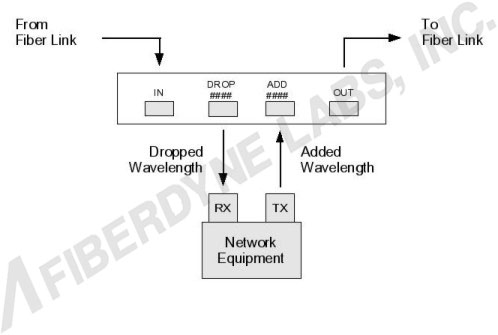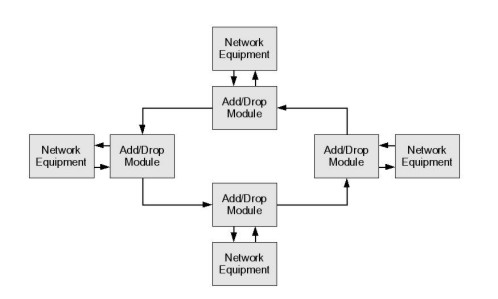
Fiberdyne Labs, Inc. An Introduction to Coarse Wavelength Division Multiplexing
An Introduction to Coarse Wavelength Division Multiplexing
Introduction:- Wavelength Division Multiplexing (WDM) is a technique, which uses a special property of fiber-optics. This property allows the combination of multiple signals onto a single strand of fiber. Each signal is assigned to a different wavelength, of light. Since one wavelength does not affect another wavelength, the signals do not interfere.

Figure 1: Typical Application of a 1310/1550-nm WDM
Coarse WDMs perform two functions. First, they filter the light, ensuring only the desired wavelengths are used. Second, they multiplex or demultiplex multiple wavelengths, which are used on a single fiber link (See Figures 2a & 2b). The difference lies in the wavelengths, which are used. In CWDM space, the 1310-band and the 1550-band are divided into smaller bands, each only 20-nm wide. In the multiplex operation, the multiple wavelength bands are combined (i.e. muxed) onto a single fiber. In a demultiplex operation, the multiple wavelength bands are separated (i.e. demuxed) from a single fiber. The used wavelengths are defined by the International Telecommunications Union; reference ITU G.694.2 for the ITU CWDM Wavelength Grid.
Note: The CWDM Grid lists eighteen center wavelengths, from 1270 nm to 1610 nm, at 20 nm spacing.
PDF Version of web page

Specifications for "Standard" CWDM Modules

Application Note

 |  |
|
| Figure 2: (A) Using a Multiplexer (Mux) | Figure 2: (B) Using a Demultiplexer (Demux) |
In a hybrid configuration (mux/demux), multiple transmit and receive signals can be combined onto a single fiber. Each signal is assigned a different wavelength. At each end, transmit signals are muxed, while receive signals are demuxed. For example, in a simple full-duplex link, the transmit is assigned the 1530-nm wavelength, while the receive signal is assigned the 1550-nm wavelength. Additionally, individual signals can be delivered at points along a link. A receive signal is demuxed (i.e. dropped) from the link, and a new transmit signal is muxed (i.e. added) onto the link. This application is called an Add/Drop module
(See Figure 3).

Figure 3: Using an Add/Drop CWDM Module
Generally, a CWDM network takes two forms. A point-to-point system connects two locations, muxing and demuxing multiple signals on a single fiber (See Figure 4). A loop or multi-point system connects multiple locations, typically using Add/Drop modules (See Figure 5).

Figure 4: Point to Point Multiplexer Network
Using Fiberdyne equipment, you can use two implementations. In one approach (See Figure 6), Fiberdyne CWDM GBICs (Gigabit Interface Converters) are added to existing Ethernet switch equipment. The GBIC outputs feed Fiberdyne, CWDM modules. The other approach (see Figure 7) adds the Fiberdyne 3001 CWDM Optical Multiplexer System to the existing outputs of existing Ethernet switch equipment.

Figure 5: Multiplexing with Fiberdyne Add/Drop Modules

Figure 6: Multiplexing with Fiberdyne CWDM GBICs and CWDM Modules

Figure 7: Multiplexing with Fiberdyne Optical Mux System
Fiberdyne Labs, Inc. carries a complete line of CWDM products at our Frankfort, New York, facility.
Call your Fiberdyne Sales Representative at 800-894-9694 or email us at
An Introduction to Coarse Wave Division Multiplexers (CWDM)
- ∙ Field Modules
- ∙ Mini Field Modules
- ∙ LGX Modules
- ∙ LGX Add/Drop Modules
- ∙ 1U Rack-mount Modules
- ∙ 1U Rack-mount Add/Drop Modules
- ∙ Campus CWDM System
- ∙ Fiberdyne Labs Metro Cisco® compatible CWDM System
- ∙ CWDM + DWDM LGX Modules
- ∙ CWDM + DWDM LGX Add/Drop Modules
- ∙ CWDM + DWDM 19/23 Rack-mount
- ∙ CWDM/DWDM Doubler Field Module
- ∙ CWDM/DWDM Doubler LGX Module
- ∙ CWDM FCX-2150
- ∙ CWDM FCX-2160
- ∙ CWDM FCX-2170
- ∙ LGX Combiner Separator Filters
- ∙ LGX 5 Channel Mux/Demux
- ∙ LGX 10 Channel Mux/Demux
- ∙ LGX Mux/Demux with High Density LC/APC or UPC